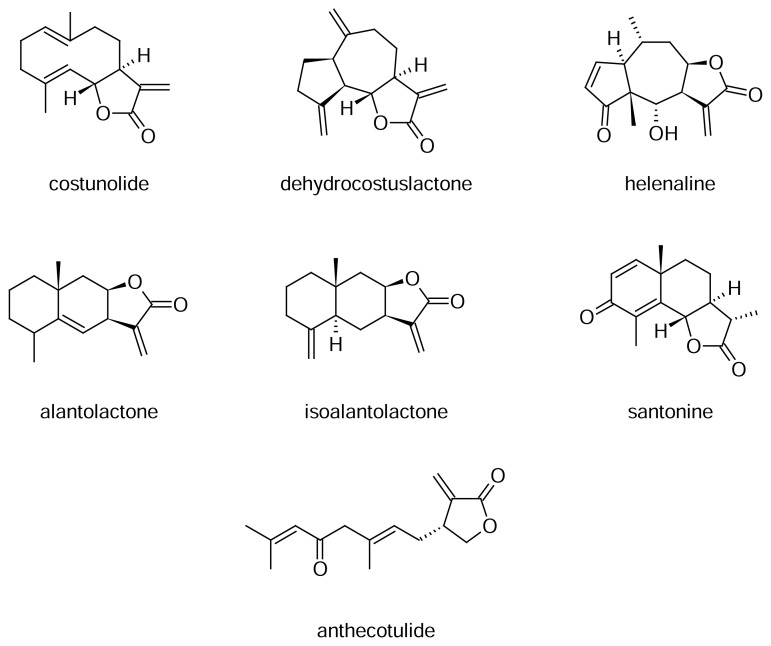Sesquiterpene Lactone Analysis Service
Submit Your InquiryWhat is Sesquiterpene Lactone?
Sesquiterpene lactones, often found in various plant species, are a subgroup of terpenoids. What sets them apart is their distinctive 15-carbon backbone, known as a sesquiterpene, which is coupled with a lactone ring. This combination of structural elements confers upon sesquiterpene lactones their unique chemical and biological properties.
One of the remarkable features of sesquiterpene lactones is their chemical diversity. These compounds exist in a multitude of structural variants, each characterized by variations in the lactone ring and the sesquiterpene moiety. This diversity results in a wide range of bioactivities, making sesquiterpene lactones a treasure trove for researchers in search of novel therapeutic agents.
Within the plant kingdom, sesquiterpene lactones serve as a formidable line of defense. When herbivores or pathogens threaten a plant, these compounds are often the first line of protection. Their bitterness deters herbivores from consuming the plant, while their antimicrobial properties help combat invading pathogens. Additionally, the characteristic odor associated with some sesquiterpene lactones can repel potential threats.
The study of sesquiterpene lactones goes far beyond their role in plant defense. Researchers are increasingly drawn to these compounds due to their potential in various fields, including medicine, agriculture, and ecology. Understanding sesquiterpene lactones at a molecular level can unlock their therapeutic potential, shed light on plant interactions with the environment, and offer new avenues for crop protection.
 Chemical structures of selected sesquiterpene lactones
Chemical structures of selected sesquiterpene lactones
Sesquiterpene Lactone Analysis Project in Creative Proteomics
Creative Proteomics offers a comprehensive sesquiterpene lactone analysis service that includes the following specific projects:
Sesquiterpene Lactone Identification: Accurate identification of sesquiterpene lactones present in a given sample.
Quantitative Analysis: Precise quantification of sesquiterpene lactone levels in samples.
Metabolite Profiling: Profiling of sesquiterpene lactone metabolites to understand their distribution in biological systems.
Structural Elucidation: Determination of the chemical structure of sesquiterpene lactones using advanced spectroscopic techniques.
Bioactivity Assessment: Evaluation of the biological activities of sesquiterpene lactones, such as their anti-inflammatory or anti-cancer properties.
Sesquiterpene Lactone Assay Platforms
High-Resolution Mass Spectrometry (HRMS)
HRMS is a cornerstone technique in our sesquiterpene lactone analysis. The Orbitrap Fusion™ Tribrid™ Mass Spectrometer stands at the forefront of HRMS technology. This instrument offers exceptional resolving power and mass accuracy, enabling the precise determination of the molecular weight of sesquiterpene lactones.
HRMS is particularly advantageous when dealing with complex samples, as it can resolve closely eluting compounds, minimizing the risk of false positives or negatives in the analysis.
Liquid Chromatography-Mass Spectrometry (LC-MS)
The Agilent 1290 Infinity II LC System, in conjunction with the Agilent 6545 Q-TOF Mass Spectrometer, forms a powerful combination for the separation and quantification of sesquiterpene lactones.
This LC-MS system excels in providing high sensitivity, resolution, and mass accuracy. It enables us to separate sesquiterpene lactones from complex matrices and precisely quantify their concentrations, even in trace amounts. Moreover, the Q-TOF (Quadrupole Time-of-Flight) technology enhances the accuracy of mass measurements, facilitating the identification of sesquiterpene lactones in samples.
Gas Chromatography-Mass Spectrometry (GC-MS)
For the analysis of volatile sesquiterpene lactones, we employ GC-MS using the Agilent 7890B Gas Chromatograph and Agilent 5977B Mass Spectrometer. This combination excels in separating and detecting volatile compounds with precision.
GC-MS is particularly useful when studying sesquiterpene lactones that exhibit low boiling points or are prone to vaporization. The GC-MS system ensures accurate and reproducible results in such cases, contributing to the comprehensiveness of our analysis.
Sample Requirements for Sesquiterpene Lactone Assay
| Sample Type | Sample Volume/Weight | Sample Storage Conditions | Additional Notes |
|---|---|---|---|
| Plant Extracts | 1-5 grams | Freeze at -80°C | Avoid repeated freeze-thaw cycles. |
| Cell Cultures | 1-5 million cells | Freeze at -80°C | Include information on cell culture medium and treatment. |
| Biological Fluids | 0.5-1 mL (serum/plasma/urine) | Store at -80°C | Provide detailed information on sample type and handling. |
Applications of Sesquiterpene Lactone Analysis
Drug Discovery: Sesquiterpene lactones, with their complex chemical structures and diverse biological activities, offer promise as potential drug candidates. Our analysis aids in identifying novel compounds for pharmaceutical research.
Agriculture and Crop Protection: Understanding sesquiterpene lactones is crucial in developing eco-friendly strategies for pest control and crop protection, reducing reliance on chemical pesticides.
Phytochemical Research: Our analysis contributes to a deeper understanding of plant biochemistry and ecological interactions, shedding light on plant adaptation, evolution, and ecological relationships.
Food and Flavor Industry: Certain sesquiterpene lactones are responsible for the characteristic bitterness and aroma of foods and beverages. Our analysis aids in food product development and flavor enhancement.
Environmental Monitoring: Sesquiterpene lactone analysis can be employed in environmental studies to assess plant health and the impact of environmental stressors, providing valuable insights into ecosystem dynamics.
Data Analysis for Sesquiterpene Lactone Assay
| Data Analysis Component | Description |
|---|---|
| Data Preprocessing | - Raw data preprocessing to remove noise and artifacts. - Alignment of retention time and mass spectra. |
| Peak Detection | Identification of peaks corresponding to sesquiterpene lactone metabolites. |
| Metabolite Identification | - Matching detected peaks to known sesquiterpene lactone metabolites from databases. - Structural elucidation of unknown metabolites when possible. |
| Quantitative Analysis | Determination of metabolite concentrations based on peak intensities. |
| Statistical Analysis | - Statistical tests (e.g., t-tests, ANOVA) to identify significant differences between sample groups. - Multivariate analysis (e.g., PCA, PLS-DA) for pattern recognition. |
| Pathway Analysis | - Mapping metabolites onto metabolic pathways to identify affected pathways. - Enrichment analysis for pathway-level insights. |
| Visualization | - Generating heatmaps, scatter plots, and volcano plots to visualize data trends. - Creation of pathway maps to illustrate metabolic changes. |
| Report Generation | Compilation of a comprehensive report summarizing analysis results and conclusions. |
Reference
- Salapovic, Helena, Johannes Geier, and Gottfried Reznicek. "Quantification of sesquiterpene lactones in asteraceae plant extracts: Evaluation of their allergenic potential." Scientia Pharmaceutica 81.3 (2013): 807-818.

